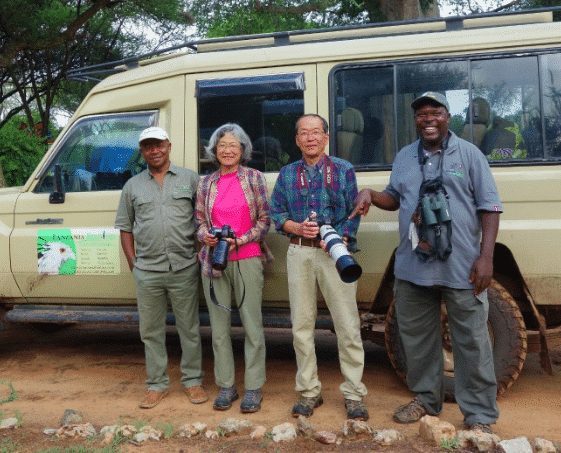“DECEMBER 2019 – THE TOUR EXPERIENCE JUST BEFORE THE WORLD PANDEMIC –COVID 2019”
Birding & Wildlife experience: visiting the Serengeti, Ndutu region, Ngorongoro Crater, Arusha, Lake Manyara and Tarangire National Parks.
A Private Birding and Photographic Tour for a Japanese Couple: Akio and Yasuko Yamada.
Tour Organizer: Tanzania Birding & Beyond Safaris
Bird Guide: Anthony Raphael
Safari Driver: Geitan
Safari Dates: 8th – 18th Dec 2019
Why Tanzania – ?
Despite the Long Rains that Tanzania and most of Africa experienced in excess of the normal during the late 2019, Our Tanzanian Tour in Dec 2019 was hassle free to say. This was a private Birding and Photographic Tour organized by a local Birding Company in Tanzania: Tanzania Birding & Beyond Safaris, arranged the tour for my Wife Yasuko and I Akio Yamada from Japan. As we all know ,the Covid-19 Pandemic had not spread the panic into the world yet by mid Dec 2019, so all was smooth with us, you are welcome to read ahead……….
In Japan, we have nearly 600 bird species in, but the number includes those species that are extremely rare migrants. It is therefore quite challenging for the birders in Japan to observe all the birds recorded in this country. Ordinary Japanese birders perhaps could watch around 300 species in their lifetime in Japan.
We started birding well over 30 years before and the numbers of bird species we have observed has exceeded 300 species in Japan. It takes special efforts in order to see rare migrants visiting the Japanese Archipelago, one has to arrange several trips visiting remote islands at a limited time window of the year. Moreover, recent habitat loss in Japan as well as the destruction of stopovers for migratory birds make it relative difficult to find even bird species that used be commonly found in Japan. This way we have decided to go overseas for birding, particularly Asian countries.
We realized that visiting the area where those rare visitors normally reside is much easier for us to meet them rather than visiting a remote small island. Our interests in exotic birds expand and we have visited handful of countries including Malaysia, Thailand, Australia, Mongolia, Netherland, Spain and Costa Rica.
However we have had a long time love and interest for the African Continent too. We have met a number of people who have visited Africa and strongly recommended that we do visit this wonderful continent that is a birders paradise! Our desire to be there grew up rapidly; however, Africa is a huge continent and we had no idea where to go. During our search for a better place, my wife Yasuko found a web site that specializes in Birding Tours in East Africa, this was a company called Tanzania Birding and Beyond Safari. It seemed for us, as far as we looked at the web site, that Tanzania was full of fun. We learned we could enjoy variety of big games along with bird species that we have never seen before. We therefore made a contact with Tanzania Birding and Beyond Safaris office by email to Tina at the office, and eventually decided to ask them the best time to visit. After several discussions, our tour was set to start December 8th, 2019. Here we go…..
We chose a Qatar airline departing the Narita International Airport at 22:00 on Dec 7th which arrived at Doha at 4:10 on Dec 8th after 11:30 hour flight. We spent nearly 4 hours at the Doha International Airport until next flight to Tanzania. We were expecting to see Mt. Kilimanjaro from the window before landing. Because we reserved left-side window seats, we could see a huge mountain just before landing, as expected. We took many photos, but a gentleman sitting in front of me told that that’s not Kilimanjaro but Mount Meru. Mt. Kilimanjaro was covered with thick clouds and could not be seen, unfortunately. We eventually arrived at the Kilimanjaro International Airport at 14:40 with approximately an hour delay.
A driver from the company was waiting for us and he drove us to the lodge. On the way to the lodge, the driver told me that the guide was on the phone and he wanted me to talk over the phone. We were expected to see the guide, Anthony, at the lodge, but he told me that he could not show up. We had to kill a time after checking in the lodge without guide. The lodge in Arusha was Ngare Sero Lodge that have huge private land with river running through forest. While wandering around, we met one of the lodge staff and he told us there was a big eagle. We asked him right away to take us there. There it was. A beautiful African Fish Eagle was perching on the dead tree sticking out of the river. We were so excited that we took uncountable pictures of him without knowing that we were going to see many of them at the different places. In that evening we saw 10 species, all of which were lifers for us.
During enjoying superb dinner at the restaurant, it started rain, and it was still raining when we got back to our room. The room was just great. We could fall asleep without feeling any jet lag that night.
This morning after our Breakfast, we met Anthony and Geitan at the lodge and our safari tour began. On the way to the Arusha National Park we saw several songbirds including endemic Taveta Weaver. Our top priority bird today is Turaco. Unfortunately, however, we were surrounded by deep fog when we got to the point where they were expected to be seen, because of rather high altitude. Anthony found a flock of Hartlaub’s Turaco, but because they were moving quickly around forest canopy, it was hard for us to look at them. The fog made the matter worse. They just looked like dark grey moving objects. We took many photos, but none of them could tell us how they truly look. We were shocked and disappointed. But every cloud has a silver lining. The second time we encountered a flock of Hartlaub’s Turaco, abruptly the fog was cleared away. Now we could not only see them but capture some photos of them. We realized we were not that unfortunate, because we were trapped by the fog again only 5 or 10 minutes later.
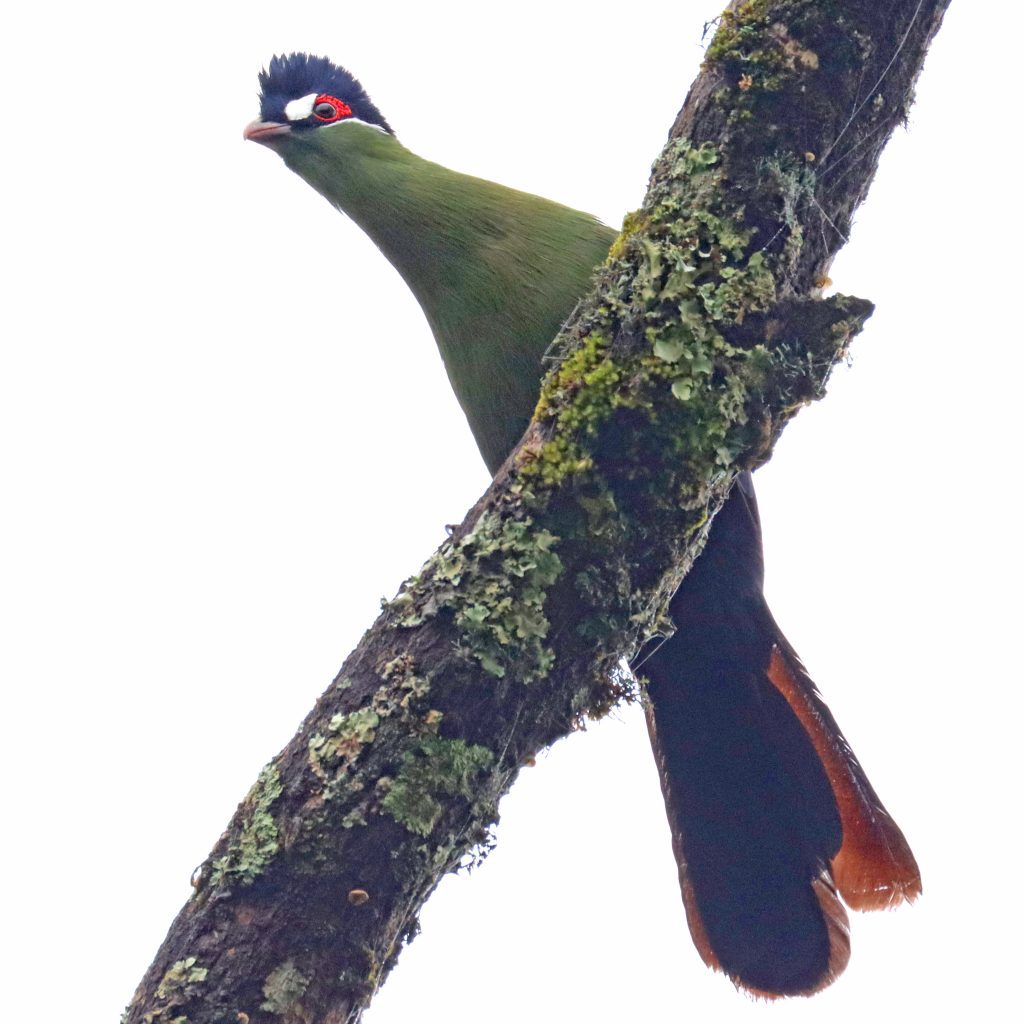
Now that we accomplished our first and big mission that day, we were able to relax and enjoy mammals such as Giraffe, Buffalo, Zebra, Warthog, Bushbuck, Waterbuck, Blue monkey, Olive baboon, and Black and white colobus.
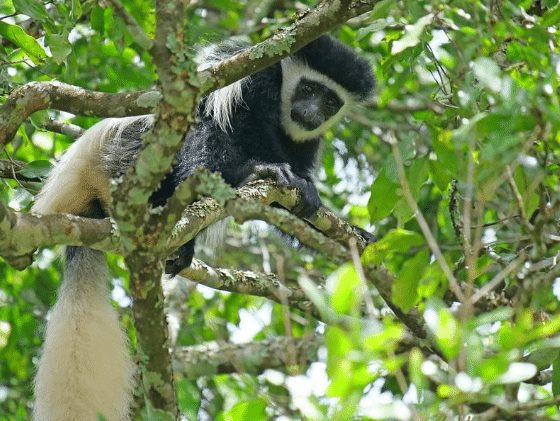
After enjoying our box lunch at the edge of a lake, we returned to the lodge and enjoyed afternoon birding inside the lodge property. In addition to the species we saw on day 1, we could see Giant Kingfisher, Black Crake, Brown-hooded Kingfisher and others. Anthony told us that African Black Duck could be only seen at this place.
We (Geitan, actually) had to drive to Serengeti, more than 350 km away, this day. It would take over 7 hours, but we could stop for a short while if there were something we could not miss. When we made a brief stop at a shopping mall outskirt of Arusha city, we found a beautiful Lilac-breasted Roller sitting on a tree. But the distance between he and we did not allow me to take a good shot. While I was wasting precious time to try to take nice photos of the Lilac-breasted Roller. Anthony came closer to me and told that something quite interesting was sitting in the yard next to the mall. At first, I couldn’t tell what it was, but a couple of minute later I found a gigantic bird in the yard. “Wow, Shoebill!”, I was about to scream. That was my first time to see real Shoebill. I knew that this particular bird always remains still when he is waiting for his prey; however, this guy moved a lot contrary to my expectation. Anthony told me that he was in captivity there so that we decided not to include him in our check list.
Because of heavy thunder shower, we were forced to take our box lunch inside the safari car. Having lunch while listening to falling rain in a safari car was a kind of exciting experience for us. We got over the Great Rift valley and entered the huge savanna area around 16:30. Our drive continued and on the way to the Ngorongoro Conservation Area we encountered many African fauna like Kori Bustard, Thompson’s gazelle, Common Wildebeest, Common Eland, Crowned Lapwing and so on.
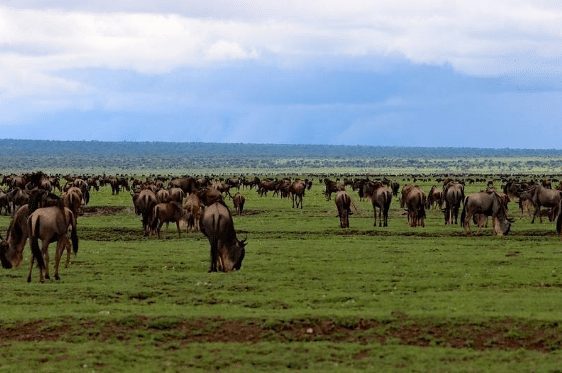
Although we wanted to pull over several times to observe them in more detail, Anthony and Geitan looked like they did not care. They told us it would take more than 2 hours to get our destination of the day, meaning that we would be able to have a glass of cold beer around 18:30. That’s not too bad, I thought. Our safari car, however, stopped abruptly. It was quite unbelievable that there was a traffic jam. Traffic jam in Serengeti? At first, I thought there were some sort of big games like Lions or Cheetahs. No, the traffic jam was due to a flood. The road ahead of us was completely blocked by a torrent river instantly formed after the thunder shower. “How long we have to wait here?” I asked to Geitan. He replied, “Nobody knows, we just wait until the water level lowers and the road is re-open.” We waited almost an hour without doing anything, but finally cars started to move.
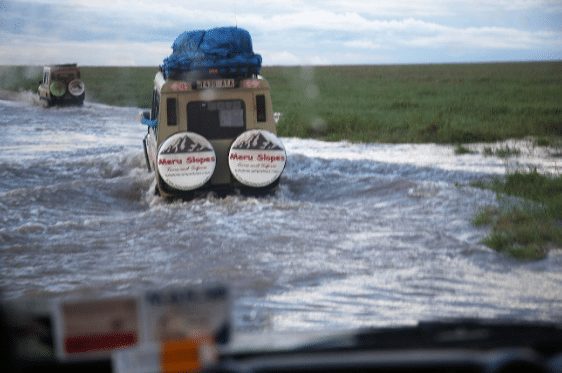
I was very much relieved because I knew that I would not miss a glass of cold beer that night. We arrived at the Kubu Kubu tented Lodge around 19:00. In this lodge all drinks including alcoholic beverages are free and the dinner was superb. Even though our cabin was right next to the restaurant, we were instructed not to go out in the dark without escort by Maasai worriers. The cabin was very well designed and surprisingly the shower room was outdoor. We took shower under moon light. It was a little chilly, though. We went bed and around mid-night we heard lions were roaring.
We woke up around 5:30 in the morning and found the rising sun was illuminating the Serengeti savanna. After enjoying very yummy breakfast, our hunting with cameras and binoculars but armories started again. On the way to the savanna, Anthony asked us what bird species we wanted to see the most. That was a kind of tough question for us because we need to look carefully into our field guidebook to name it. But Yasuko, bravely enough, said that Lilac-breasted Rollers were her primary target. I thought Anthony grinned. We later understood why he grinned at that time. There were so many of them. They were literally everywhere.
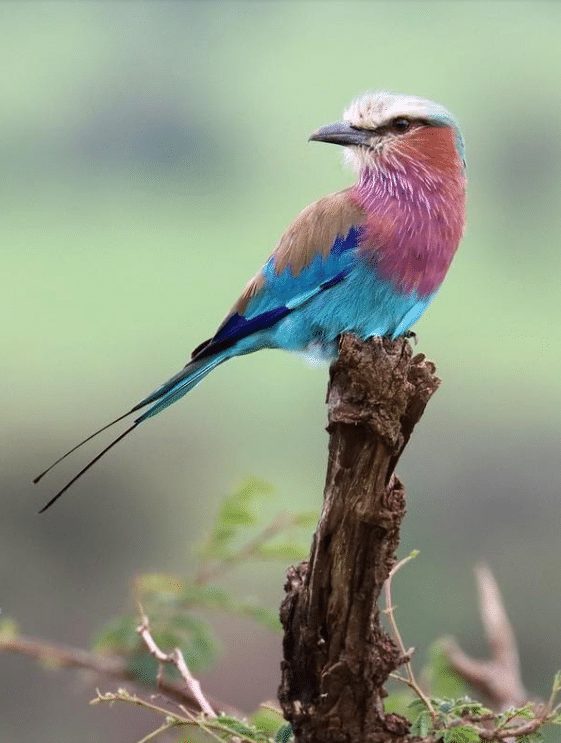
We met many bird species around the visitor center like Dark Chanting Goshawk, Chinspot Batis, Red-fronted Barbet and Red-cheeked Cordon-bleu. In the afternoon there came a great news that a big cat was found. We hurried to the place without caring about any other living creatures. There it was. A leopard was on the tree feasting on an unfortunate warthog.
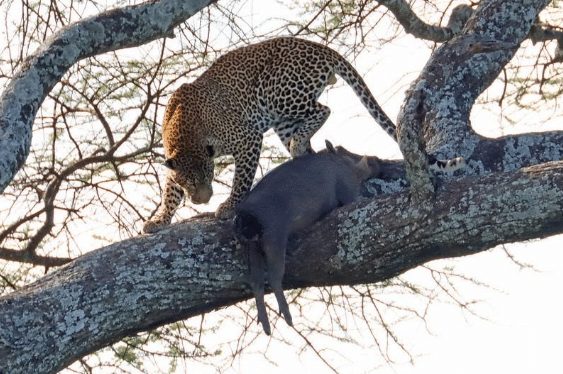
Our dinner was prepared by a lady chef, Veronica. Everything was fine with red wine imported from South Africa. Anthony asked me to give my name to Veronica. He was grinning at that time, too. When I told her my first name, she exploded with laughter. Anthony explained with grinning that my first name, Akio, sounded like the name of a tribe living around Mt. Meru. After that moment, it appeared that I became the most famous Japanese guest in this lodge. Everybody who saw me begun to say “Hi Akio” with smiling. Akio is a name from a tribe on the slopes of Mt Meru in Northern Tanzania- a surprise !!!
We departed the Kubu Kube tented Lodge around 8:00 am and headed to Ndutu Safari Lodge. We dropped by the Serengeti Visitor Center to have our lunch. Around the picnic area, there were two different species of hyrax which we could not distinguish very well. We spent about one and half hours there looking for birds and animals until it started to rain. It rained cats and dogs, but it ceased soon. Tanzanian Red-billed Hornbill, Flappet Lark, Marabou Stalk, Rappet-faced Vulture, Ruppell’s Vulture, Silverbird, Superb Starling, Usambiro Barbet, Bar-faced Go-away-bird, Pigmy Falcon, Blue-napped Mousebird, Abyssinian Schimitarbill, Kori Bustard, Black-bellied Bustard, Secretarybird, Greater Kestrel, and Black-chested Snake Eagle. We met many birds that day including one of our target birds, Secretarybird, on the way to Ndutu.
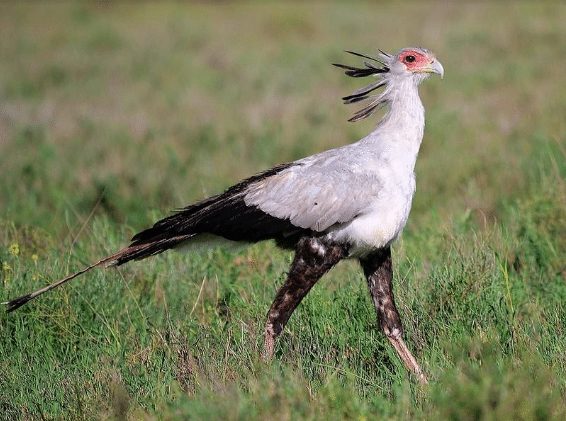
Because Ndutu Safari Lodge is also in the middle of the wildlife territory, we were required to be escorted by a guard man who was bringing a robust flush light with him. While having superb cuisines with beer and wine both named Serengeti, we confirmed the birds we encountered that day. Then a night visitor appeared. A genet was having his meal on a ceiling log.
Our exploration around Ndutu area started at 7:30 in the morning. Because this area is the only place where we can drive off Road, we decided to enjoy off-road adventure. However, the surface was so muddy due to recent heavy rain fall that we could not pull over, because the car would be stuck and not be able to escape once it stopped moving. We might have missed some important species during that move. We were relieved when we found ourselves out of the muddy area and our search for Cheetahs begun.
All of a sudden, we felt a big shock. Although Geitan did his job very well in terms of getting out of the wet muddy swamp, we were trapped by a hidden pitfall on the ground covered with grasses. Right side rear tire fell into the hole. Anthony and Geitan asked us if we were OK. Yasuko and I were all right, but we wondered if we could get out. We might need a tow away rescue. I was worried if there were no rescue coming to help us. Would we become special dinner for big cats tonight? But both guys looked like they kept calm. Geitan started to talk to somebody over the radio transmitter. I did not exactly how long we waited, but 5 or 10 minutes later there came another safari car. The driver of the car joined our team and they connected both cars with a steel wire. But when I glanced at the wire, I saw it heavily rusted. The driver of the rescue car started the engine and the engine roared. The first trial, however, failed because the rusted wire was broken away. I was very much concerned, what if we could not get out of here. Do we have to be starved this night? Do we have to be awakened all night here to watch out for predators?
The second trial begun with the wire tighten by their hands. The engine roared again. After a couple of minutes pulling, our car moved and eventually was pulled out from the big hole, thanks to the rescue driver. The solidarity is always important to accomplish some tough jobs.
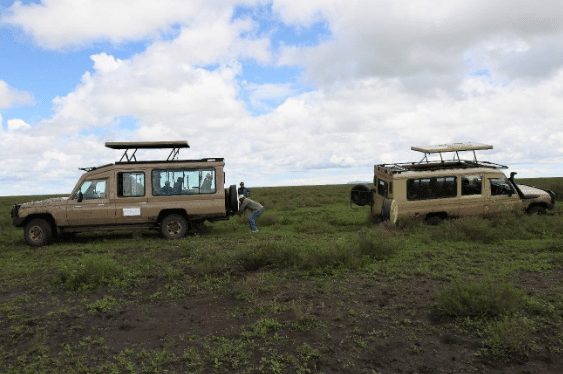
We resumed our search for Cheetahs and eventually we could find people watching at something.
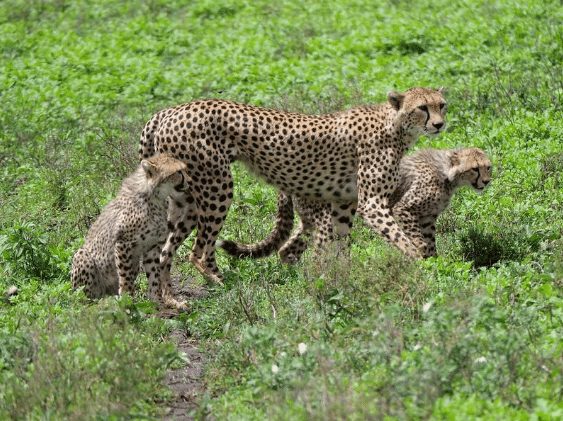
A Cheetah family was there, mother and two cubs. They move, then we follow them, they move we follow. We got hundreds of photos of them. That was real fun.

In the afternoon, we then encountered a flock of young lions. A female lion tried to vamp males but in vain. Males were yawning and appeared not interested in young attractive females, probably because they were exhausted after all night long walking through their territories.
We had another night visitor at the restaurant while having dinner. Can you guess what it was? Dreadfully enough, I found a scorpion on the floor of the restaurant. That was my first time to see such a dreadful creature in my life. Luckily, no harm, though.
Today we depart the Ndutu region and the beautiful Ndutu Safari Lodge. Heading to the Ngorongoro Crater and a request for a cultural Tour on the way, to visit the people, this was the local Maasai Tribesman village…
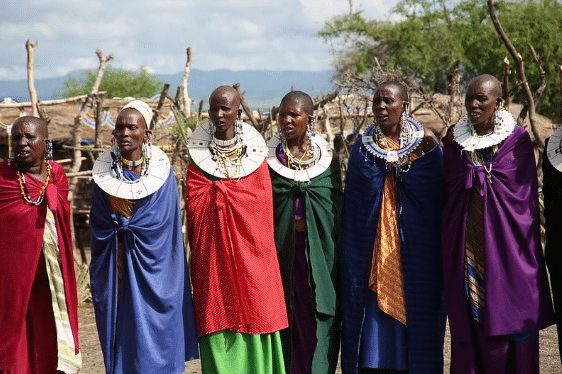
It was not serious at all, but something was wrong with my bowl movement on this day. I was worried I would need to go to the toilet during our driving. Anthony and Geitan told me that they would try to stop at the places where the “toilet” was available. On the way to Ngorongoro Crater, we made a short visit to a Maasai village where a son of the chief conducted guided tour in the village. He showed us their hat including inside and explained how they used such a small hat in highly organized manner. He also took us to a village kindergarten, and we had a chance to see small kids were studying. About an hour later the tour ended. Suddenly I realized that I was at the brink of emergency. I urgently needed to go to the toilet. I found a tiny stone building which looked like a toilet. Anthony and Geitan, however, did not recommend to use it. But I could not hold it and there was no other option. I got a permission from the son of the chief to use it. The big problem had been solved right away.
On the Crater Floor, we spent afternoon doing birding at the Ngorongoro crater. We met all the members of the “Big Five” here. Three Black Rhinoceroses were seen in the heat haze, and Elephants were beautiful in green floor of the crater.
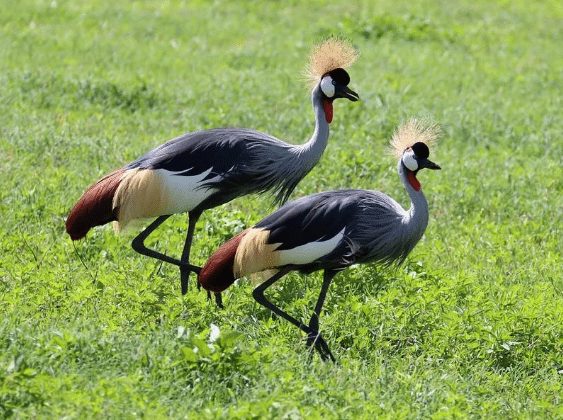
We met one of our target birds, Grey Crowned Crane. Three species of teals, Hottentot, Cape and Red-billed were in the same field of view. We also witnessed a small but funny battle between Pink-backed Pelican and African Fish Eagle. Weather was so clear that we could observe beautiful landscape of Ngorongoro crater from a lookout.
We arrived at the upgraded Kitela Lodge instead of the Marera Valley Lodge, because the latter was under renovation toward Christmas season. The Kitela lodge is owned by the same guy who operates the Kubu Kubu tented Lodge. The lodge was just gorgeous for us. Around 18: 45 Anthony found a Montane Nightjar flying over the swimming pool. I grabbed my camera and rushed to the pool side, but it was impossible for me to take photo, since it was already too dark. Because drinks were all free of charge again, we consumed too much alcohol. It was a kind of surprise to find hot water bottles were prepared in our bed. It was truly kind and warm courtesy, but a bit too warm for us.
A lot had been said and read about the Lake Manyara Jungles with its Tree climbing Lions and the fantastic water birds of Lake Manyara National Park.
We were expecting to see fantastic large Flamingo gathering in the Lake Manyara, but unfortunately, we were disappointed to know the fact that recent floods significantly increased the influx of water into the lake leading to the quite change in the habitat for flamingos. However, we were satisfied with the presence of the tree-climbing lions and impressive Southern Ground Hornbill and other species of birds. Emerald-spotted Wood-dove was far prettier as compared to the picture in the field guide.
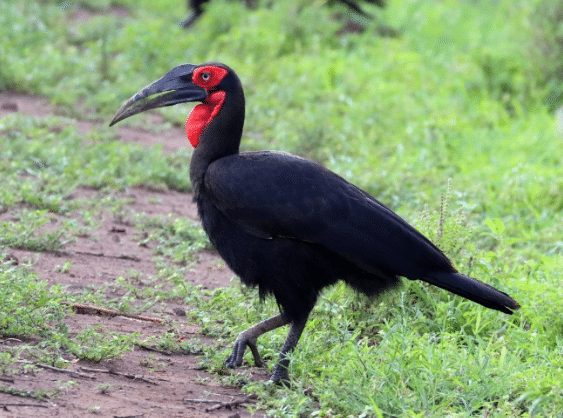
The Afternoon birding was at the garden of the Kitela Lodge where we met our Tacazze Sunbird, Red-chested Cuckoo, African Paradise Flycatcher, Red-billed Firefinch, Black-headed Oriole, and Arrow-marked Babbler. Before dinner we saw White-browed Robin-Chat and Cardinal Woodpecker at the Kitela Lodge.
At the dinner Yasuko and I enjoyed chats with Anthony thanks to yummy dishes and free red wine. hahahahhah
This morning, we checked out of the Kitela Lodge and left the Ngorongoro Highlands area.
My bowl problem was not over yet and I needed frequent visits to the toilets during our birding and driving to the next accommodation. Even under such condition, birding is of our primary importance. We therefore visited several spots around the Lake Manyara. Movement of Black Heron (umbrella bird) was so funny. A Malachite Kingfisher was holding a pose on a tree branch in a scrub quite close to us. We saw Saddle-billed Stork, too.
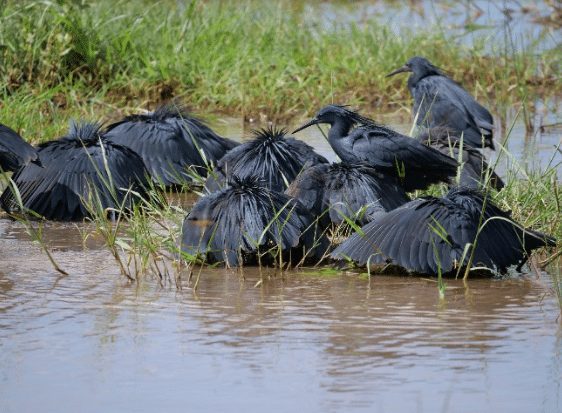
Then we had a relatively long lunch time at the picnic area just in case I had to use the toilet. We were lucky to find a flock of small birds making noisy sounds. Amid of those birds, there was a Pearl-spotted Owlet. Small birds were trying to get rid of the owlet. This reminded me of Vietnamese bird guide who was always mimicking an Owlet voice using a kind of whistle when birds were became scarce. I now know the reason why he made such a mysterious sound. We also encountered Red and Yellow Barbet, very famous species because they are iconic birds being put on a cover of famous book entitled “Birds of East Africa”.
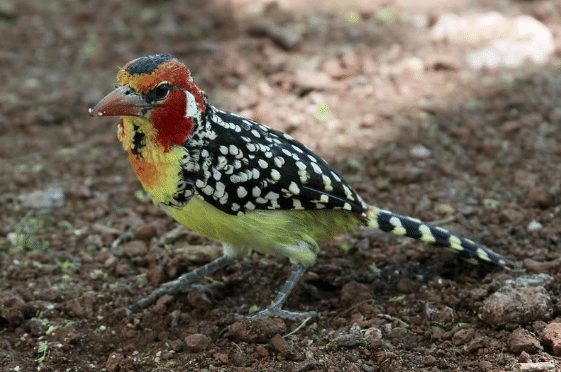
At the entrance of Tarangire National Park, a park staff sprayed insecticide over the entire body of our safari car for prevention of Tsetse flies. We saw Green Wood Hoopoe while we were waiting for our vehicle ready. Around 16:30 we arrived at the Tarangire Safari Lodge safely. This one is totally different from those tent lodges we stayed before. This is the real one. We were advised not to bring anything edible inside the tent, otherwise we would be attacked by big games while we were sleeping.
Although buffet dinner was great, I could not enjoy because I had not good appetite because of my bowl condition. Regretfully I missed many cousins on that night. Yasuko tried to take photos of the galaxy spreading over the Tarangire plain because the sky was so clear without moon light.
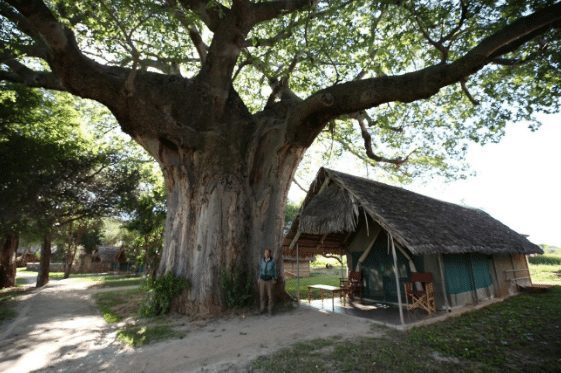
Our excitements continued. But Anthony was also excited on that day because we encountered a couple of Three-banded Courser. According to him, he could see them approximately once in 10 visits in Tarangire National Park. We also enjoyed seeing that a pair of Von der Decken’s Hornbill was taking sand bath together. A flock of Elephants accompanied by babies was found bathing in a pond. A pair of Secretarybird was nesting on an acacia tree. White-bellied Go-away-bird and Von der Decken’s Hornbill appeared to be residents in this lodge. Differentiation between Northern and Tanzanian Red-billed Hornbills was quite challenging. We were completely confused until we got back to Japan and found the description in the report written by Anthony.
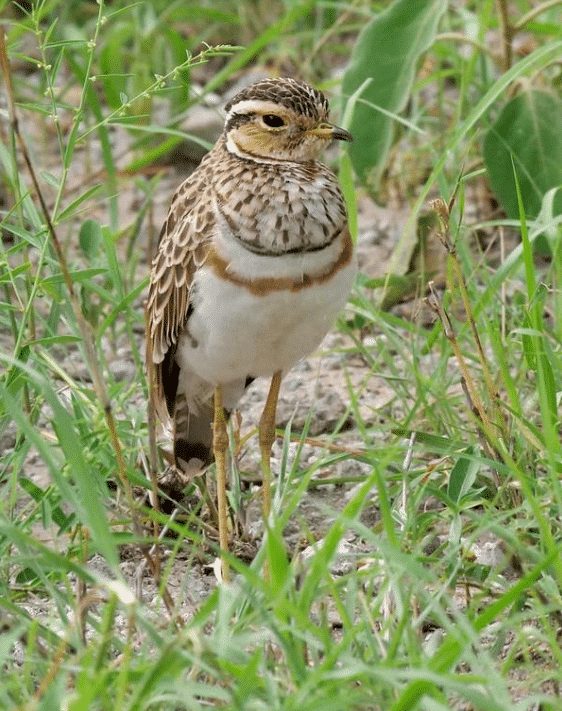
Whereas the end of our tour was approaching, surprisingly, new species such as Red-headed Quelea, Red-bellied Parrot, Woodland Kingfisher, and White-bellied Bustard, still continued to appear.
Our accommodation was at this beautiful Trangire Safari Tented Lodge. Thanks to Tina at the Tanzania Birding and beyond office to select this as a way to end the tour… the views and scenery not easy to put in just one sentence, should it be, awesome, breathtaking, eye catching, lovely, overwhelming, inspiring, memorable or what would you think……..?
We were supposed to arrive at the Kilimanjaro International Airport around 13:00 suggesting that we still had a couple of hours to do birding inside the national park while driving toward the entrance. Just before departure, Anthony found a bunch of Peter’s Dwarf Epauletted Fruit Bat hanging from a tree branch. He also pointed a new bird perching on another tree branch, African Scops Owl. On the way to the airport we still found new species like Foxy Lark, Blue-cheeked Bee-eater, and Red-necked Spurfowl.
This gives the impression,” Birding in Tanzania is Endless” This should answer the question: WHY TANZANIA?
In Arusha, Anthony our guide dropped off the car and Geitan took us to the airport. Then it was time to say goodbye to Geitan and Goodbye to Tanzania!
Our Tally went as follows:
304 Bird Species seen on the Trip
264 Bird Species Lifers for Yasuko
231 Bird Species Lifers for me (Akio)
262 Bird Species Photographed
46 Mammals seen
BIG THANK YOU to TANZANIA BIRDING & BEYOND SAFARIS, All the Crew Anthony our Top Bird Guide and Geitan our Excellent and Safe Safari Driver for a “NZURI SANA” SAFARI
